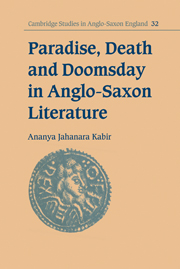Book contents
- Frontmatter
- Contents
- Preface
- List of abbreviations
- 1 Between Eden and Jerusalem, death and Doomsday: locating the interim paradise
- 2 Assertions and denials: paradise and the interim, from the Visio Sancti Pauli to Ælfric
- 3 Old hierarchies in new guise: vernacular reinterpretations of the interim paradise
- 4 Description and compromise: Bede, Boniface and the interim paradise
- 5 Private hopes, public claims? Paradisus and sinus Abrahae in prayer and liturgy
- 6 Doctrinal work, descriptive play: the interim paradise and Old English poetry
- 7 From a heavenly to an earthly interim paradise: toward a tripartite otherworld
- Select bibliography
- Index
4 - Description and compromise: Bede, Boniface and the interim paradise
Published online by Cambridge University Press: 19 October 2009
- Frontmatter
- Contents
- Preface
- List of abbreviations
- 1 Between Eden and Jerusalem, death and Doomsday: locating the interim paradise
- 2 Assertions and denials: paradise and the interim, from the Visio Sancti Pauli to Ælfric
- 3 Old hierarchies in new guise: vernacular reinterpretations of the interim paradise
- 4 Description and compromise: Bede, Boniface and the interim paradise
- 5 Private hopes, public claims? Paradisus and sinus Abrahae in prayer and liturgy
- 6 Doctrinal work, descriptive play: the interim paradise and Old English poetry
- 7 From a heavenly to an earthly interim paradise: toward a tripartite otherworld
- Select bibliography
- Index
Summary
Transmission is not a term which should be understood in a mechanical sense. What was handed on were not merely books but ideas which, being alive, change and are changed in the historical worlds they successively penetrate.
In the second chapter, I discussed Ælfric's response to the Vision of Dryhthelm in Bede's Historia Ecclesiastica. I now return to the Vision of Dryhthelm and another Anglo-Latin vision of the otherworld which preceded the Historia Ecclesiastica by just fourteen years – that experienced by a monk of the Monastery of Wenlock, and recounted by Boniface in a letter written to Abbess Eadburg in 716 or 717 AD. Both visions describe a remarkably similar otherworld, in which two regions of punishment mirror two pleasant regions. This four-part otherworld is a more schematised and visually charged presentation of the same hierarchies between an interim paradise and heaven on the one hand, and two infernal regions on the other, which inform the ‘Three Utterances’ homilies from at least a century later.
In this chapter, I investigate how and why these visions incorporate the concept of an interim paradise into their four-part otherworld, and the reciprocal impact of the literary form of the vision on the interim paradise. This close interaction of theological and literary interests is achieved through several stages of reappropriation, or the transmission and transformation of ideas, which I recover through analysis of the framework, structure and imagery of both visionary otherworlds.
- Type
- Chapter
- Information
- Paradise, Death and Doomsday in Anglo-Saxon Literature , pp. 77 - 110Publisher: Cambridge University PressPrint publication year: 2001



